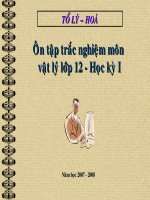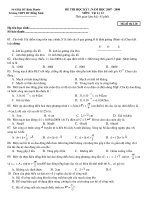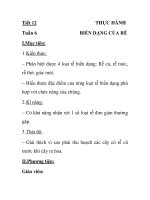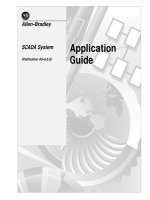12 SFC programming i Training PLC Allen Bradley
Bạn đang xem bản rút gọn của tài liệu. Xem và tải ngay bản đầy đủ của tài liệu tại đây (301.94 KB, 46 trang )
DAY 3
SESSION 4
12-1
SEQUENTIAL FUNCTION CHART (SFC)
PROGRAMMING I
Sequential Function Chart (SFC) Programming I
6 – 10 December 2010
WHAT IS SFC ?
• Stand for: SEQUENTIAL FUNCTION CHART
• SFC is similar to a flow-chart of your process
12-2
• SFC defines the steps or states through which your system
progresses
Sequential Function Chart (SFC) Programming I
6 – 10 December 2010
12-3
SFC SCHEMA
Sequential Function Chart (SFC) Programming I
6 – 10 December 2010
WHEN TO USE SFC ?
Use SFC to:
• Organize the functional specification for your system
12-4
• Program and control your system as a series of steps and
transitions
Sequential Function Chart (SFC) Programming I
6 – 10 December 2010
SFC OVERVIEW
STEP
ACTION
TRANSITION
12-5
QUALIFIER
Sequential Function Chart (SFC) Programming I
6 – 10 December 2010
SFC OVERVIEW
12-6
SIMULTANEOUS
BRANCH
Sequential Function Chart (SFC) Programming I
6 – 10 December 2010
SFC OVERVIEW
SELECTION
BRANCH
TEXT BOX
12-7
STOP
Sequential Function Chart (SFC) Programming I
6 – 10 December 2010
BASIC ELEMENTS IN SFC
12-8
STEP
• Represent a major function of process
Sequential Function Chart (SFC) Programming I
6 – 10 December 2010
BASIC ELEMENTS IN SFC
STEP
• Contains the actions that occur at a particular time, phase, or
station.
• Executes continuously until a transition tells the SFC to go to the
next step.
ACTION
12-9
• One of the functions that a step performs.
Sequential Function Chart (SFC) Programming I
6 – 10 December 2010
BASIC ELEMENTS IN SFC
TRANSITION
12-10
• Defines the physical conditions that must occur or change in order
to go to the next step.
• If true, go to the next step.
• If false, repeat the step above.
Sequential Function Chart (SFC) Programming I
6 – 10 December 2010
BASIC ELEMENTS IN SFC
SELECTION BRANCH
12-11
• Only one path executes.
• Checks from left to right the transitions that start each path. It
takes the first true path.
• If no transitions are true, the SFC repeats the previous step.
Sequential Function Chart (SFC) Programming I
6 – 10 December 2010
BASIC ELEMENTS IN SFC
SIMULTANEOUS BRANCH
12-12
• Execute 2 or more steps at the same time
• All paths must finish before continuing the SFC
• Checks the ending transition after the last step in each path has
executed at least once. If the transition is false, the SFC repeats
the previous step
Sequential Function Chart (SFC) Programming I
6 – 10 December 2010
BASIC ELEMENTS IN SFC
LOOP BACK
12-13
• Loop back to a previous step
• Connect the wire to the step to which you want to go
Sequential Function Chart (SFC) Programming I
6 – 10 December 2010
BASIC ELEMENTS IN SFC
TEXT BOX
• Lets you add descriptive text or notes to your SFC
QUALIFIER
• Determines when an action starts and stops
STOP
Sequential Function Chart (SFC) Programming I
12-14
• Lets you stop and wait for a command to restart
6 – 10 December 2010
BASIC ELEMENTS IN SFC
SEQUENCE
12-15
• A group of steps that execute one after the other.
Sequential Function Chart (SFC) Programming I
6 – 10 December 2010
STEP STRUCTURE
• Each step uses a tag to provide information about the step
12-16
• Access this information via the Monitor Tags tab of the Tags
window
Sequential Function Chart (SFC) Programming I
6 – 10 December 2010
STEP STRUCTURE
Property
Function
T
Determine how long a step has been active
(milliseconds)
X
Do something while the step is active (including first
and last scan)
Do something one time when the step becomes active
SA
Do something while the step is active, except on the
first and last scan
12-17
FS
Sequential Function Chart (SFC) Programming I
6 – 10 December 2010
STEP STRUCTURE
Property
Function
Do something one time on the last scan of the step
TMax
Determine the maximum time that a step has been
active during any of its executions
Count
Determine how many times a step has become active
12-18
LS
Sequential Function Chart (SFC) Programming I
6 – 10 December 2010
12-19
STEP STRUCTURE
Sequential Function Chart (SFC) Programming I
6 – 10 December 2010
ACTION TYPE
NON BOOLEAN
12-20
• Contains the logic for the action
• Uses structured text to execute assignments and instructions
• Call a subroutine
Sequential Function Chart (SFC) Programming I
6 – 10 December 2010
ACTION TYPE
Use structured text assignments, constructs, and instructions
12-21
Call a subroutine
Sequential Function Chart (SFC) Programming I
6 – 10 December 2010
ACTION TYPE
BOOLEAN
• Contains no logic for the action
• It simply sets a bit in its tag (ACTION Structure)
12-22
• To do the action, other logic must monitor the bit and execute
when the bit is on
Sequential Function Chart (SFC) Programming I
6 – 10 December 2010
ACTION STRUCTURE
• Use actions to divide a step into the different functions that the
step performs, such as commanding a motor, setting the state
of a valve
12-23
• Each action (non-boolean and boolean) uses a tag to provide
information about the action
Sequential Function Chart (SFC) Programming I
6 – 10 December 2010
ACTION STRUCTURE
Property
Function
Q
Determine when the action is active
T
Determine how long a step has been active
(milliseconds)
Determine how many times a step has become active
12-24
Count
Sequential Function Chart (SFC) Programming I
6 – 10 December 2010
QUALIFIER
• Each action (non-boolean and boolean) uses a qualifier to
determine when it starts and stops
• The default qualifier is Non-Stored
12-25
• The action starts when the step is activated and stops when
the step is deactivated
Sequential Function Chart (SFC) Programming I
6 – 10 December 2010









